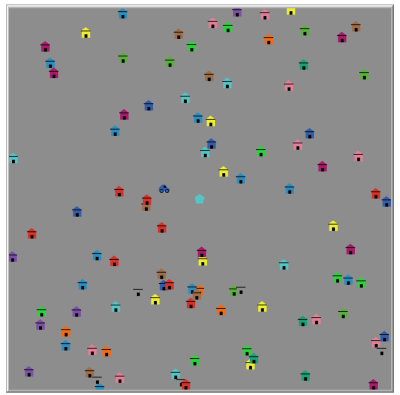Simulation of product distribution
Title: Simulation of product distribution
Author: Lucia Pavlíková
Method: Agent-based model
Tool: NetLogo
Problem definition
This project explores the optimization of delivery times for distribution vehicles in a city (London) with a complex and challenging logistics environment. This study focuses on key variables that impact delivery efficiency, such as traffic congestion, weather conditions, variability in package handling, and scenarios of unavailability of recipients. The aim is to provide insights and strategies for businesses to enhance their urban distribution operations, making this research relevant for both academic and practical applications in urban logistics.
Method
The model for this project simulates the distribution process in a city (London) using an agent-based approach in NetLogo. In this model, agents represent different elements of the distribution network (delivery vehicle, customers, storage facility). External factors include weather conditions or customers availability.
Model
The model for this project simulates the distribution process in London using an agent-based approach in NetLogo. It begins with a map of the world - onto which various distribution elements, such as vehicles, storage facilities, and delivery locations, are placed.
Environment
The simulation takes place within the city. Delivery locations are randomly generated within the simulation, each assigned a position in a Cartesian coordinate system. Each household is designated to receive one package. Once the final package is delivered, the vehicle returns to the storage facility, using the button “go to storage”.
Agents
In this model, agents represent different elements of the distribution network. Delivery vehicle is the primary agents. Storage facility and delivery locations are also represented, serving as starting and ending points for the distribution journey.
Movement
The movement of vehicles is a crucial aspect of the model. Vehicles navigate through the city, contending with variables such as traffic congestion, day of the week, weather or time of the day. Their movement patterns are influenced by all of the variables.
Distribution Process
The model for this project simulates the distribution process in a city (London) using an agent-based approach in NetLogo. In this model, agents represent different elements of the distribution network (delivery vehicle, customers, storage facility). External factors include weather conditions or customers availability.
The core of the model is the distribution process, where vehicles collect packages from storage facilities and deliver them to designated stores or direct to customers.
External Factors
External factors like weather conditions and traffic congestion are integrated into the model. The model allows for the customization of these variables to simulate different scenarios.
End of the Simulation
The simulation concludes when all scheduled deliveries are completed. The model provides data on delivery costs and potential bottlenecks in the distribution process.
Results
Conclusion
Code
Sources
- https://www.britannica.com/place/London/Transportation
- https://www.holiday-weather.com/london/averages/
- https://www.quora.com/How-common-are-thunderstorms-in-London
- https://weatherspark.com/y/45061/Average-Weather-in-City-of-London-United-Kingdom-Year-Round
- https://content.tfl.gov.uk/travel-in-london-2023-road-traffic-trends-acc.pdf
- https://ccl.northwestern.edu/netlogo/docs/programming.html
- https://logistiko.eu/help/goods-delivery-procedure
